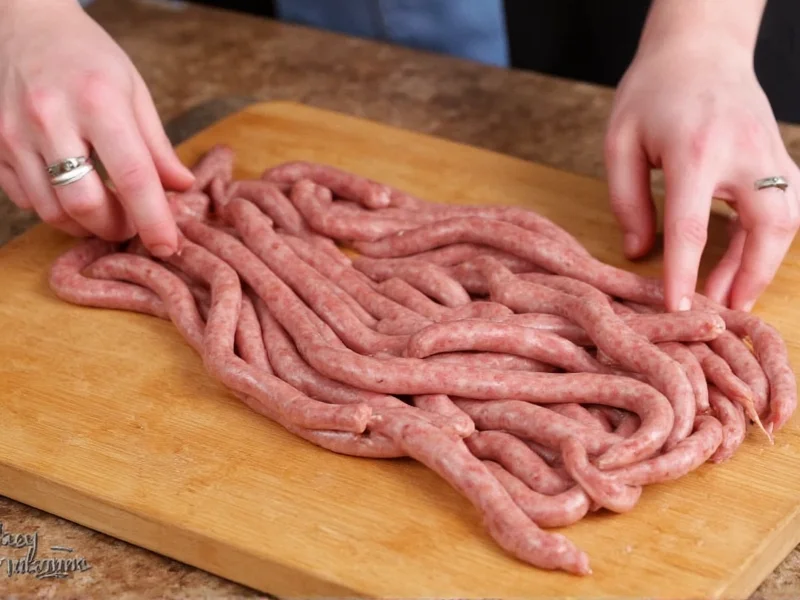Creating delicious homemade sausage is a rewarding culinary skill that puts you in control of ingredients and flavors. Unlike store-bought varieties filled with preservatives and fillers, homemade sausage allows you to customize seasonings, control fat content, and ensure food safety throughout the process. Whether you're making breakfast links, Italian sausage, or bratwurst, the fundamental techniques remain consistent.
Essential Equipment for Sausage Making
Before starting your sausage making journey, gather these critical tools. While professional setups exist, home cooks can achieve excellent results with basic equipment:
| Equipment | Home Option | Professional Option | Key Considerations |
|---|---|---|---|
| Meat Grinder | Stand mixer attachment or manual grinder | Commercial electric grinder | Must handle cold meat; avoid overheating |
| Sausage Stuffer | Grinder attachment or plunger stuffer | Vacuum stuffer | Prevents air pockets in casings |
| Casings | Natural hog or sheep casings (soaked) | Prefilled casing tubes | Natural casings provide traditional texture |
| Thermometer | Digital instant-read | Multiple-probe system | Critical for food safety verification |
Selecting Quality Ingredients
The foundation of exceptional sausage begins with premium ingredients. For traditional pork sausage, shoulder (Boston butt) provides the ideal 70% lean to 30% fat ratio. Beef sausage benefits from chuck roast, while poultry sausages work well with thigh meat and added fat.
Seasoning balance makes or breaks your homemade sausage recipe. The standard formula includes:
- 2.5% salt by weight (essential for protein extraction)
- 0.25% curing salt for smoked varieties (optional)
- 2% sugar for balance
- Spices to taste (typically 1-3% total)
Always chill your meat and equipment before beginning the grinding process. Meat temperature should remain below 40°F (4°C) throughout preparation to prevent fat smearing and ensure proper texture.
Step-by-Step Sausage Making Process
Follow these precise steps for successful sausage creation:
- Prepare ingredients: Cube meat into 1-inch pieces, trim excess sinew, and chill thoroughly (at least 2 hours). Soak natural casings in lukewarm water for 30 minutes if using.
- First grind: Using the coarse plate (⅜" or 10mm), grind chilled meat and fat through your grinder. Keep everything cold—consider placing grinder parts in freezer beforehand.
- Mix and season: In a large bowl, combine ground meat with seasonings. Mix vigorously for 2-3 minutes until sticky and emulsified. This develops the protein structure critical for texture.
- Test cook: Fry a small patty to check seasoning and adjust if necessary. This step is crucial for perfecting your homemade sausage recipe before committing to the entire batch.
- Second grind (optional): For finer texture, pass mixture through a smaller plate (¼" or 6mm).
- Stuff casings: Attach stuffer, thread casing onto tube, and fill slowly to avoid air pockets. Twist into desired link lengths.
- Rest and set: Refrigerate sausages for 12-24 hours before cooking to allow flavors to meld.
Food Safety Considerations for Homemade Sausage
Safety is paramount when handling raw meat. Maintain temperatures below 40°F (4°C) during preparation and never leave sausage mixture at room temperature for more than 20 minutes. Cook sausages to proper internal temperatures:
- Pork and beef: 160°F (71°C)
- Poultry: 165°F (74°C)
- Pre-cooked sausages: 140°F (60°C)
Store fresh sausage in the refrigerator for up to 2 days or freeze for 2-3 months. When freezing, use vacuum sealing for best results to prevent freezer burn. Never refreeze thawed sausage.
Troubleshooting Common Sausage Making Issues
Even experienced sausage makers encounter challenges. Here's how to address frequent problems:
- Dry sausage: Increase fat content in your next batch. The ideal ratio is 70% lean meat to 30% fat for most varieties.
- Crumbly texture: Insufficient mixing or warm temperatures during preparation. Ensure thorough mixing and keep everything cold.
- Casings breaking: Overfilling or inconsistent pressure during stuffing. Fill casings about 90% capacity and maintain steady pressure.
- Bland flavor: Under-seasoning or inadequate resting time. Always test cook before final seasoning and allow proper resting time.
- Fat separation: Meat temperature too high during grinding. Chill components thoroughly and work quickly.
Popular Sausage Variations to Try
Once you've mastered the basic technique, experiment with these traditional sausage recipes:
- Breakfast sausage: Combine pork with sage, thyme, red pepper flakes, and a touch of maple syrup for classic morning links.
- Italian sausage: Add fennel seeds, garlic, and crushed red pepper to pork for sweet or hot varieties.
- Bratwurst: Use pork and veal with nutmeg, ginger, and white pepper for authentic German flavor.
- Chorizo: Blend pork with smoked paprika, garlic, and vinegar for Spanish-style sausage.
Each regional variety has specific seasoning ratios and preparation methods that define its character. Research traditional sausage recipes from your desired cuisine for authentic results.
Mastering the Art of Sausage Making
Perfecting homemade sausage requires attention to detail but yields exceptional results. The key to successful sausage making lies in maintaining cold temperatures, proper seasoning balance, and thorough mixing. Document your recipes and adjustments to refine your technique with each batch. Remember that slight variations in meat quality, fat content, and seasoning can significantly impact the final product.











 浙公网安备
33010002000092号
浙公网安备
33010002000092号 浙B2-20120091-4
浙B2-20120091-4